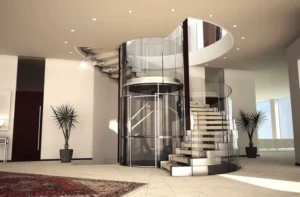Home elevators have become an essential solution for multi-story residences, offering convenience, accessibility, and enhanced property value. Among various drive systems, traction home elevators are widely used due to their smooth operation, energy efficiency, and space optimization. However, different structural designs impact installation complexity, performance, and maintenance requirements.
There are three main types of traction home elevators: gantry frame type, backpack type, and forced-drive traction elevators. Each structure has unique mechanical characteristics that influence stability, space requirements, and application scenarios. Understanding these differences helps homeowners make informed decisions based on their building conditions and personal needs.
This article provides an in-depth analysis of these three structures, their working principles, advantages, and suitability for different residential environments.
Gantry frame type traction home elevator

The gantry frame structure is one of the most commonly used designs in both residential and commercial traction elevators. It features a dual-rail support system, where the elevator cabin moves along two vertical guide rails, balanced by a counterweight. The traction motor and drive system pull the cabin and counterweight in opposite directions, ensuring smooth and energy-efficient movement.
Structural features and working principle
The traction motor is usually installed at the top of the shaft (or in a side-mounted configuration for space-saving purposes).
The counterweight moves on a separate guide rail opposite the cabin, maintaining balance and reducing power consumption.
The steel wire ropes or belts run over a traction sheave, creating a controlled lifting mechanism.
Advantages
- High stability and load capacity – The dual-rail support minimizes lateral movement, providing a smoother ride.
- Suitable for larger cabins – Can accommodate multiple passengers or wheelchair accessibility.
- Energy efficiency – The counterweight system reduces motor workload, lowering electricity consumption.
- Long-term durability – Well-suited for high-frequency use, requiring minimal maintenance.
Disadvantages
- Requires a larger shaft space – Needs adequate space for both the cabin and counterweight system.
- More complex installation – Requires a reinforced elevator shaft and additional structural considerations.
Application scenarios
Gantry frame traction elevators are ideal for newly built houses, villas, and multi-story homes with sufficient shaft space. They offer superior ride comfort and reliability, making them the preferred choice for long-term residential use.
Backpack type traction home elevator
The backpack-type structure is a compact alternative to the gantry frame design. Instead of placing the counterweight in a separate shaft section, the counterweight is positioned directly behind the elevator cabin, creating a space-saving system while retaining the core advantages of traction technology.

Structural features and working principle
- The traction motor is installed at the top or side of the shaft.
- The counterweight is fixed behind the cabin, reducing the overall width requirement.
- The system operates with a single guide rail for the counterweight, minimizing shaft size.
Advantages
- Compact design – Requires less shaft width compared to the gantry frame type.
- Easier installation – Works well in retrofitted spaces or homes with limited shaft dimensions.
- Lower cost – Uses fewer structural components, making it more affordable than dual-rail systems.
- Retains traction technology benefits – Provides smooth operation and energy efficiency.
Disadvantages
- Lower load capacity – The counterweight’s placement limits the maximum weight capacity.
- Slightly reduced stability – The single-sided support system may have minor cabin vibrations compared to dual-rail designs.
Application scenarios
Backpack-type traction elevators are best suited for homes with limited space, such as small villas, apartments, or retrofit projects where a traditional elevator shaft cannot be accommodated.
Forced-drive traction home elevator

The forced-drive traction elevator is a specialized design that eliminates the counterweight system entirely. Instead, it relies on a high-torque motor to directly drive the elevator cabin, making it an excellent choice for ultra-compact installations or buildings where counterweight space is unavailable.
Structural features and working principle
The traction motor is mounted directly on the shaft or integrated into the guide rail system.
The cabin is moved purely by motor force, without a counterweight balancing system.
Electronic braking and load detection systems ensure smooth deceleration and energy efficiency.
Advantages
- Eliminates counterweight space requirements – Allows installation in extremely confined areas.
- More flexible installation – Can be positioned in stairwells, along outer walls, or in existing structures.
- Faster construction time – Reduces civil engineering requirements, leading to shorter installation periods.
- Compact and lightweight – Ideal for homes with restrictive architectural conditions.
Disadvantages
- Higher energy consumption – The motor must fully lift the cabin without counterweight assistance.
- Increased maintenance requirements – More mechanical stress on the motor may require frequent servicing.
- Limited lift height – More suitable for low-rise homes rather than high-rise applications.
Application scenarios
Forced-drive traction elevators are typically used in homes where standard counterweight systems cannot be installed, such as historic buildings, space-limited houses, or buildings requiring minimal structural modifications.
Comparison of the three traction home elevator structures
| Feature | Gantry Frame Type | Backpack Type | Forced-Drive Type |
| Stability | ★★★★★ (Very Stable) | ★★★★☆ (Moderate) | ★★★☆☆ (Good) |
| Load Capacity | ★★★★★ (High) | ★★★★☆ (Medium) | ★★★☆☆ (Limited) |
| Space Requirement | ★★☆☆☆ (Large) | ★★★★☆ (Compact) | ★★★★★ (Minimal) |
| Energy Efficiency | ★★★★★ (Efficient) | ★★★★☆ (Efficient) | ★★★☆☆ (Higher Consumption) |
| Installation Complexity | ★★★☆☆ (Complex) | ★★★★☆ (Moderate) | ★★★★★ (Easy) |
| Best For | Large homes, villas, high-load requirements | Small villas, apartments, retrofit projects | Ultra-compact spaces, stairwell installations |
This table provides a quick reference for comparing the three elevator structures based on performance, space requirements, and suitability for different home environments.
Conclusion
Each traction home elevator structure offers distinct advantages depending on space availability, load requirements, and installation conditions.
- Gantry frame traction elevators are the best choice for stability, comfort, and long-term use in homes with adequate shaft space.
- Backpack-type traction elevators provide a balanced solution for homes with moderate space limitations.
- Forced-drive traction elevators are the most compact option, designed for homes where traditional counterweight systems are not feasible.
Choosing the right elevator ensures safety, efficiency, and an optimal home experience. If you are considering a customized home elevator solution, LJ Elevator provides high-quality traction elevator designs tailored to your needs.





